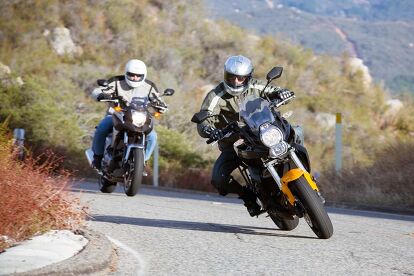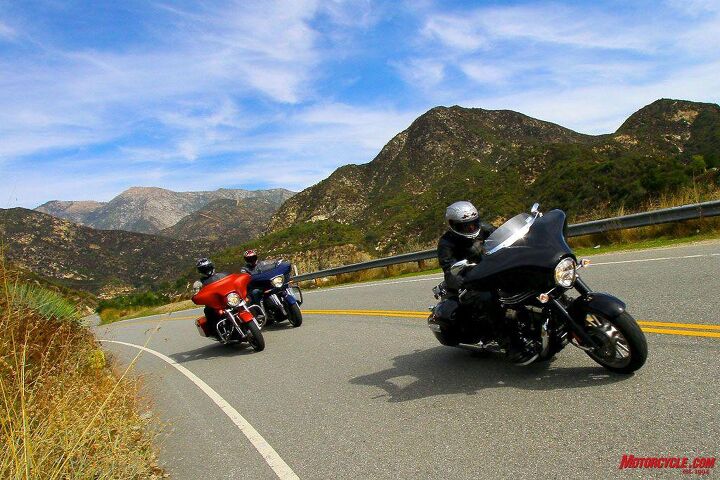Evans Off Camber - Plays Well With Others

As solitary as the act of motorcycling is, we, collectively, seem to have a compulsion to hang out with other motorcyclists even when we just bump in to them on the road. Wherever I am, whether on a bike or not, I will generally end up talking with – or at the very least acknowledging – other riders I encounter. If I’m on a bike and I have the time, I’ve even ended up spending hours riding with complete strangers.
All of this means that, on many occasions, I’ve found myself heading out onto the road with people whose skill level I didn’t know. When I was a novice, it often meant that I was riding with people who were much better riders than myself. After a couple dicey situations, I learned that I needed to focus on staying within my limits. As I progressed as a motorcyclist, the roles were more frequently reversed, and I had to remain cognizant of keeping the pace within the other rider’s skill level.
In early 1992, I’d only been riding for three years when I had my first opportunity to ride with a motojournalist. A riding buddy of mine was to be the model/rider for a Ninja 250 photo shoot, and she’d asked me to join her so that she didn’t have to ride home alone through the mountains after dark. John Burns, a newly minted freelancer after the closing of Cycle magazine, happened to be riding the other bike being shot. I was beside myself at the opportunity to be sharing the same road with a moto-god.
As we moved from one photo location to the next, I made the mistake of leaving before Burns. Within a couple corners he showed me a wheel as we entered a turn. I picked up the pace, not wanting to look bad in front of a motorcycling professional. Naturally, no matter how much faster I went, Burns was there. When I finally waved him past, aside from the ego deflation of having him pass me nonchalantly waving while I was at nine tenths of my ability, I felt relief.
Almost 10 years later, I found myself on the opposite end of a similar situation. Taking part in a ride with the readers of of my then employer, Motorcycle Cruiser magazine, I noticed that one of the guys a few bikes in front of me was early apexing the corners and exiting dangerously wide. Intent on getting in front of him to show him a proper line through the corner, I worked my way past the other riders, placing myself behind him to make a pass at the next available opportunity. Sensing me behind him, this rider naturally sped up. Most of us would.
Unfortunately, this increased speed led to the type of situation I was trying to help him avoid: his line caused him to exit the corner too early, necessitating that he lean the bike even more as he started to run wide well before the exit. Being a burly guy on a V-Star 650, he immediately ran out of ground clearance, stood the bike up, and ran off the road. The bike was still rideable, and he wasn’t too banged up. I think we both learned a lesson.
While my intentions were good, I didn’t consider how my presence would affect him. Whenever we ride with unfamiliar folks, we have the potential to get into situations like this. The solution is to think – which can be difficult to do in the moment.
In the years between those two examples, I had other opportunities to ride with motojournalists, the first in the form of the Sport Rider staff. Again, I wasn’t yet in the motorcycle industry but was just a young bike-obsessed guy. After giving me the hairy eyeball as my friend introduced me to him and the rest of the editors, Nick Ienatsch casually talked to me for a while before telling me I would be leading the ride as we left our meeting place. As I pulled out onto the road with my pulse thundering in my ears with both excitement and fear, I kept thinking to myself, “Don’t do anything stupid.” I didn’t realize until later that they were sizing me up to make sure that I wasn’t a danger to myself or them by riding over my head. Although I was by no means a regular, I did get to ride with them enough on the weekends to grow comfortable with pulling up to a stop a few minutes behind them.
When I can, I have tried to incorporate Ienatsch’s technique for checking out an unfamiliar person on a group ride, and it has served me well. However, as measured as I would like to think of myself in my approach to riding with others, I’m aware of how poorly I can react in the heat of the moment.
Last summer, while testing the BMW F800GT, I came upon a kid on a 600cc sportbike up in the Angeles National Forest. After waiting a bit for him to pull over to let me pass – as a polite rider would have done – only to have him start goosing the throttle on the straights and then over brake into the corners (with the natural result of going even slower through the turns), I became frustrated. After all, I self-righteously thought, I was working, and He. Was. In. My. Way.
I set him up for a pass on a long sweeper by entering the corner way behind him and building my closing speed through the corner. As I pulled alongside of him in the middle of the short straight, he backed off the throttle, letting me blast by – hardbags and all. Since I didn’t want to brake check him, I waited a little too long before slowing down, entering the corner a good bit faster than I liked. The front end started to chatter mid-way through the turn, sending me wide towards the double yellow. Fortunately, the fork regained composure about six inches from my making a complete ass of myself by crossing into the oncoming lane or tossing the Beemer down the road.
Chastened, I continued my ride. Not only do I need to pay attention to how my actions affect others, but I also need to pay attention to how their actions affect me.
So, when we encounter other kids while out enjoying our favorite playground. Think before you act. Our behavior affects both ourselves and the other riders around us. Consider the consequences before doing anything rash – or even considerate. Do your best to play well with others.

Like most of the best happenings in his life, Evans stumbled into his motojournalism career. While on his way to a planned life in academia, he applied for a job at a motorcycle magazine, thinking he’d get the opportunity to write some freelance articles. Instead, he was offered a full-time job in which he discovered he could actually get paid to ride other people’s motorcycles – and he’s never looked back. Over the 25 years he’s been in the motorcycle industry, Evans has written two books, 101 Sportbike Performance Projects and How to Modify Your Metric Cruiser, and has ridden just about every production motorcycle manufactured. Evans has a deep love of motorcycles and believes they are a force for good in the world.
More by Evans Brasfield




































Comments
Join the conversation
Great stuff to think about when riding with others! There are good insights in here, that would be positive additions to MSF classes.
Wow. That's a good article. I agree with Margaritas. Should be taught.